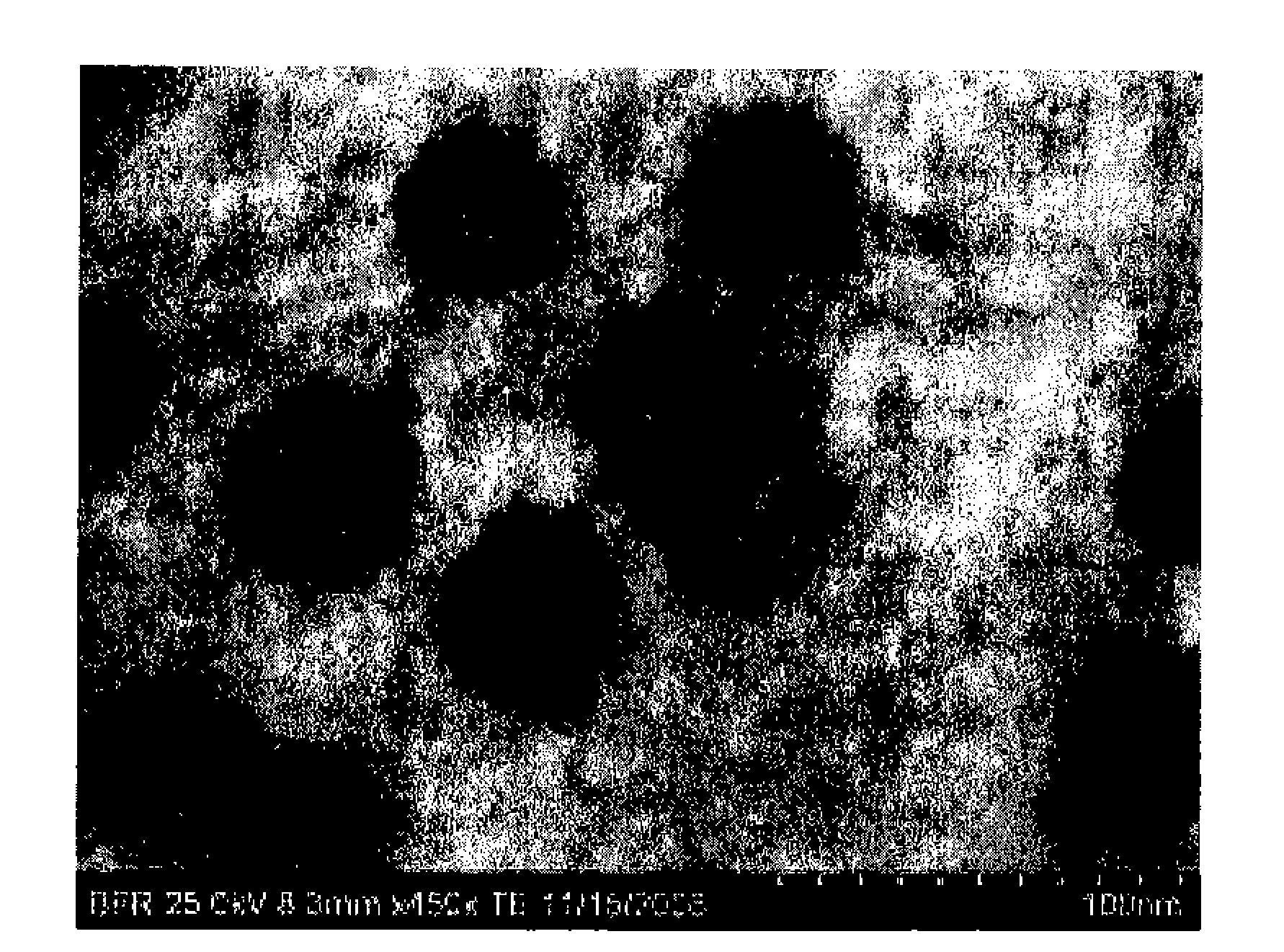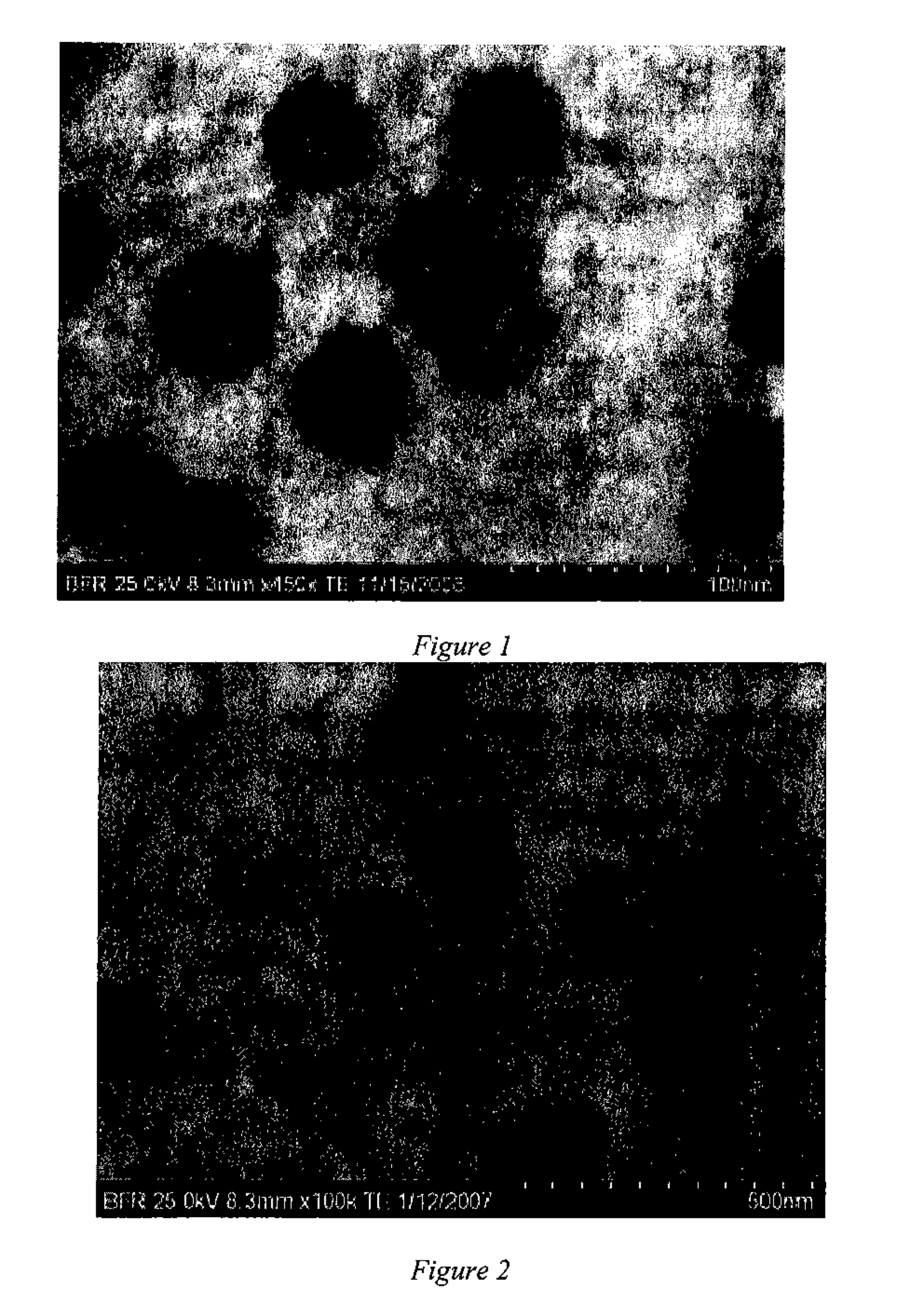Core-First Nanoparticle Formation Process, Nanoparticle, And Composition
a nanoparticle and core-first technology, applied in the field of core-first nanoparticle formation process, nanoparticle and composition, can solve the problems of difficult process capable of reliably producing acceptable nanoparticles, inability to control the size of nanoparticles during polymerization and the surface characteristics of such nanoparticles, or both, and achieve the effect of stabilizing the seed
- Summary
- Abstract
- Description
- Claims
- Application Information
AI Technical Summary
Benefits of technology
Problems solved by technology
Method used
Image
Examples
example 1
Nanoparticles Functionalized with 4-[2-Trichlorosilyl]ethylpyridine
[0088]49 g of hexane, 62 g of 34 wt % styrene and 9 ml of 5% Stereon 730AC (polystyrene-b-polybutadiene: styrene 30.6%, vinyl 8.8%, Mn 134 kg / mol) were added to the reactor. The reactor was then charged with 1.6 ml of 1.4 M sec-butyl lithium at room temperature. After approximately 1 hour, 0.1 ml of 1.6 M 2,2′-di(tetrahydrofuryl)propane and 111 g of 22 wt % 1,3-butadiene were added to the charge. After 1 day, 39 g of 33 wt % styrene was added to the charge and stirred overnight. 2 ml of divinylbenzene (DVB) was added to the reactor. After approximately 3 hours, 1.5 ml of 17.5% 4-[2-trichlorosilyl]ethylpyridine was added to the polymer in solution (cement) and stirred overnight. The cement was coagulated in isopropanol and vacuum dried.
[0089]The particle size was determined by a number average method by viewing an SEM as shown in FIG. 1. The particle size was about 50 nm. The styrene / DVB / BD particles had a weight dist...
example 2
Nanoparticles Functionalized with 9-Vinylcarbazole
[0090]49 g of hexane, 62 g of 34 wt % styrene and 9 ml of 5% Stereon 730AC (polystyrene-b-polybutadiene: styrene 30.6%, vinyl 8.8%, Mn 134 kg / mol) were added to the reactor. The reactor was then charged with 1.6 ml of 1.4 M sec-butyl lithium at room temperature. After approximately 1 hour, 0.1 ml of 1.6 M 2,2′-di(tetrahydrofuryl)propane and 111 g of 22 wt % 1,3-butadiene were added to the charge. After 1 day, 40 g of 33 wt % styrene was added to the charge. After approximately 6 hours, 2 ml of divinylbenzene (DVB) was added to the reactor and stirred overnight. 30 ml of 0.1M 9-vinylcarbazole was added to the polymer in solution (cement) and stirred for 2 days. The cement was coagulated in isopropanol and vacuum dried. The particle size was about 50 nm. The styrene / DVB / BD particles had a weight distribution of 58.4 / 3.1 / 38.5, respectively, based on the unfunctionalized particle weight. The weight percent of the 9-Vinylcarbazole functio...
example 3
Nanoparticles Functionalized with 1-Vinylimidazole
[0091]49 g of hexane, 72 g of 34 wt % styrene and 9 ml of 5% Stereon 730AC (polystyrene-b-polybutadiene: styrene 30.6%, vinyl 8.8%, Mn 134 kg / mol) were added to the reactor. The reactor was then charged with 1.6 ml of 1.4 M sec-butyl lithium at room temperature. After approximately 1 hour, 0.1 ml of 1.6 M 2,2′-di(tetrahydrofuryl)propane and 111 g of 22 wt % 1,3-butadiene were added to the charge. After 1 day, 38 g of 33 wt % styrene was added to the charge. After approximately 6 hours, 2 ml of divinylbenzene (DVB) was added to the reactor and stirred overnight. 30 ml of 0.1M 1-vinylimidazole was added to the polymer in solution (cement) and stirred for 2 days. The cement was coagulated in isopropanol and vacuum dried. The particle size was about 50 nm. The styrene / DVB / BD particles had a weight distribution of 60 / 3 / 37, respectively, based on the unfunctionalized particle weight. The weight percent of the l-vinylimidazole functional gr...
PUM
| Property | Measurement | Unit |
|---|---|---|
| average diameter | aaaaa | aaaaa |
| diameter | aaaaa | aaaaa |
| diameter | aaaaa | aaaaa |
Abstract
Description
Claims
Application Information
 Login to View More
Login to View More - R&D
- Intellectual Property
- Life Sciences
- Materials
- Tech Scout
- Unparalleled Data Quality
- Higher Quality Content
- 60% Fewer Hallucinations
Browse by: Latest US Patents, China's latest patents, Technical Efficacy Thesaurus, Application Domain, Technology Topic, Popular Technical Reports.
© 2025 PatSnap. All rights reserved.Legal|Privacy policy|Modern Slavery Act Transparency Statement|Sitemap|About US| Contact US: help@patsnap.com



